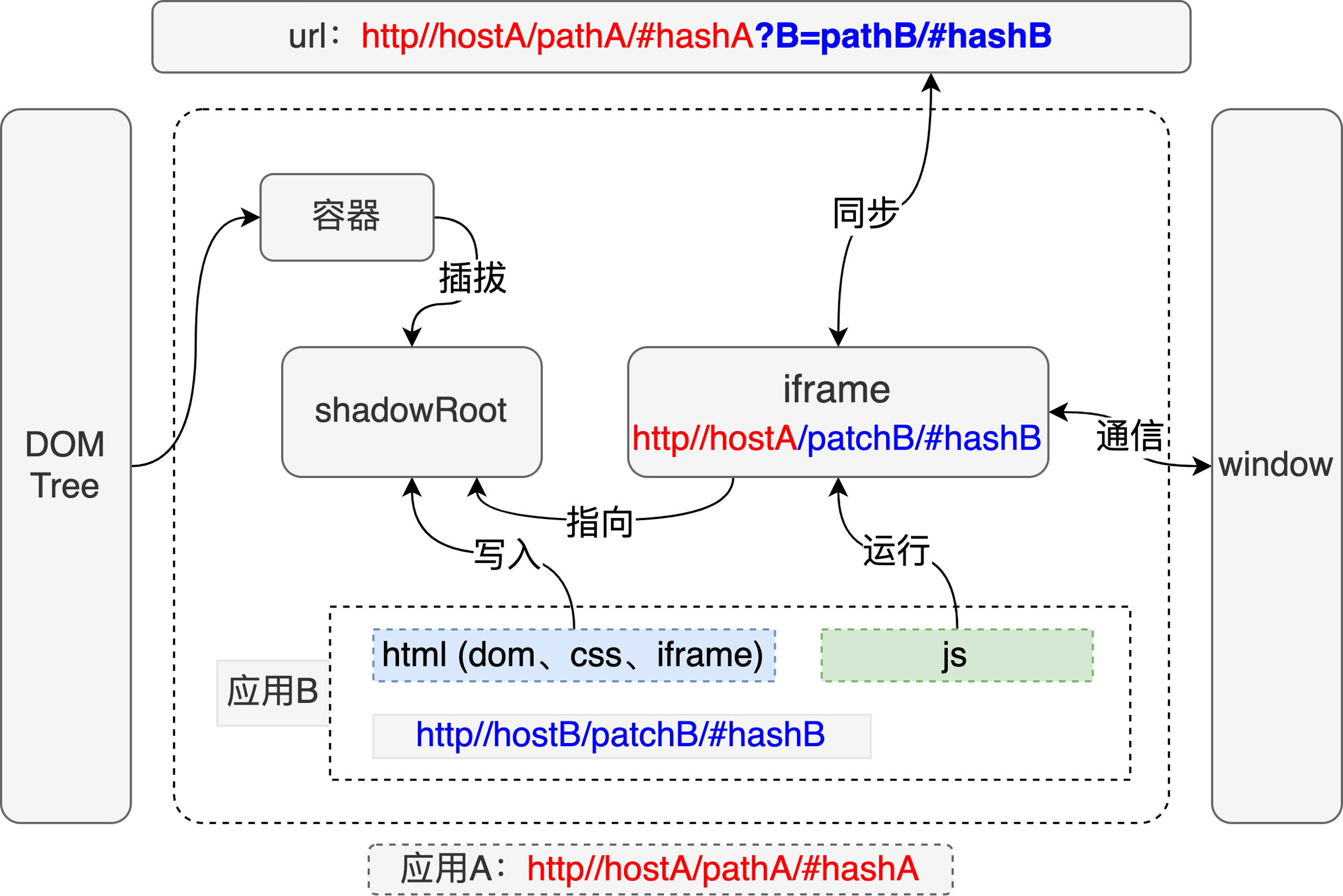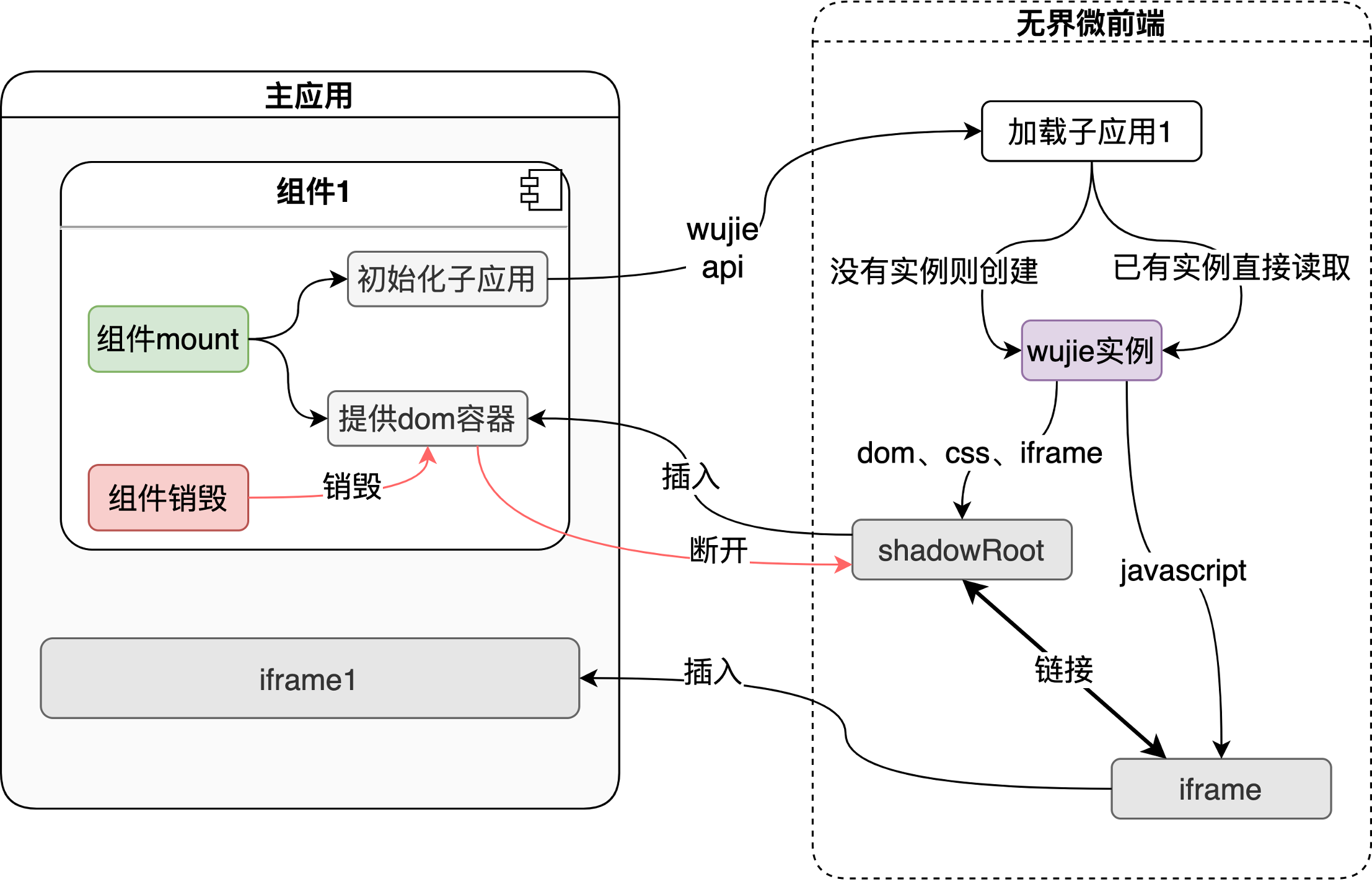原理图

运行图

从上面框架运行图可以看出,子应用的shadowRoot和iframe和承载子应用的组件是解耦的,iframe中运行着子应用的实例instance
当子应用采用保活模式时主应用切换路由,组件被销毁
子应用
shadowRoot、iframe、instance都保留当组件重新渲染,无界则将
shadowRoot重新插入组件容器即可,相当于一个shadowRoot的插拔动作
当子应用采用非保活模式时主应用切换路由,组件被销毁
子应用会调用
window.__WUJIE_UNMOUNT销毁instance并清空shadowRoot内部所有元素,但是shadowRoot、iframe都保留当子应用重新渲染
- 无界将调用
window.__WUJIE_MOUNT创建新instance - 无界将子应用的
html重新填充到shadowRoot内 - 新
instance会mount到shadowRoot上。
- 无界将调用
如果用户没有定义
window.__WUJIE_UNMOUNT和window.__WUJIE_MOUNT,那么每次组件重新渲染,都会将wujie实例包括shadowRoot、iframe全部销毁,然后重新创建wujie实例,这样会有白屏时间
思考:为什么要定义window.__WUJIE_UNMOUNT和window.__WUJIE_MOUNT这两个生命周期?
内部接口
子应用window对象拓展
interface Window {
// 是否存在无界
__POWERED_BY_WUJIE__?: boolean;
// 子应用公共加载路径
__WUJIE_PUBLIC_PATH__: string;
// 子应用沙盒实例
__WUJIE: WuJie;
// 子应用mount函数
__WUJIE_MOUNT: () => void;
// 子应用unmount函数
__WUJIE_UNMOUNT: () => void | Promise<void>;
}
无界沙箱 sandbox
/**
* 子应用的沙箱
* @author damyxu
* @since 2021-07-14
*/
export default class Wujie {
id: string;
/** 激活时路由地址 */
url: string;
/** 子应用保活 */
alive: boolean;
/** window代理 */
proxy: WindowProxy;
/** document代理 */
proxyDocument: Object;
/** location代理 */
proxyLocation: Object;
/** 事件中心 */
bus: EventBus;
/** 容器 */
el: HTMLElement;
/** js沙箱 */
iframe: HTMLIFrameElement;
/** css沙箱 */
shadowRoot: ShadowRoot;
/** 子应用的template */
template: string;
/** 子应用代码替换钩子 */
replace: (code: string) => string;
/** 子应用自定义fetch */
fetch: (input: RequestInfo, init?: RequestInit) => Promise<Response>;
/** js沙箱ready态 */
iframeReady: Promise<void>;
/** 子应用预加载态 */
preload: Promise<void>;
/** 子应用js执行队列 */
execQueue: Array<Function>;
/** 子应用执行标志 */
execFlag: boolean;
/** 子应用mount标志 */
mountFlag: boolean;
/** 路由同步标志 */
sync: boolean;
/** 子应用跳转标志 */
hrefFlag: boolean;
/** 子应用采用fiber模式执行 */
fiber: boolean;
/** 子应用styleSheet元素 */
styleSheetElements: Array<HTMLLinkElement | HTMLStyleElement>;
/** $wujie对象,提供给子应用的接口 */
provide: {
bus: EventBus;
shadowRoot?: ShadowRoot;
props?: {
[key: string]: any;
};
location?: Object;
};
/** 激活子应用
* 1、同步路由
* 2、动态修改iframe的fetch
* 3、准备shadow
* 4、准备子应用注入
*/
active(options: {
url: string;
sync?: boolean;
template?: string;
el?: string | HTMLElement;
props?: {
[key: string]: any;
};
alive?: boolean;
fetch?: (input: RequestInfo, init?: RequestInit) => Promise<Response>;
replace?: (code: string) => string;
}): Promise<void>;
/** 启动子应用
* 1、运行js
* 2、处理兼容样式
*/
start(getExternalScripts: () => ScriptResultList): Promise<void>;
mount(): void;
/** 销毁子应用 */
destroy(): void;
/** 当子应用再次激活后,只运行mount函数,样式需要重新恢复 */
rebuildStyleSheets(): void;
/** 兼容:root选择器样式到:host选择器上 */
attachHostCssRules(): void;
/**
* @param id 子应用的id,唯一标识
* @param url 子应用的url,可以包含protocol、host、path、query、hash
*/
constructor(
name: string,
url: string,
attrs: {
[key: string]: any;
},
fiber: boolean
);
}
细节
实现一个纯净的 iframe
子应用运行在一个和主应用同域的iframe中,设置src为替换了主域名host的子应用url,子应用路由只取location的pathname和hash
但是一旦设置src后,iframe由于同域,会加载主应用的html、js,所以必须在iframe实例化完成并且还没有加载完html时中断加载,防止污染子应用
提醒
- 如果
iframe没有实例化完成就进行stop,location的origin为about:blank会导致子应用路由无法运行 - 如果直接在 iframe 实例化时采用
document.write擦除,路由器的同步功能将失败
具体实现:
/**
* 防止运行主应用的js代码,给子应用带来很多副作用
*/
// TODO: 更加准确抓取停止时机
function stopIframeLoading(iframeWindow: Window) {
iframeWindow.__WUJIE.iframeReady = new Promise<void>((resolve) => {
function loop() {
setTimeout(() => {
// location ready
if (iframeWindow.location.href === "about:blank") {
loop();
} else {
iframeWindow.stop();
initIframeDom(iframeWindow);
resolve();
}
}, 0);
}
loop();
});
}
iframe 数据劫持和注入
子应用的代码 code 在 iframe 内部访问 window、location 都被劫持到相应的 proxy,注意这个闭包只是为了修改location而window和document对象和原型已经被直接修改
当采用script的type为module时会去除这个闭包,需要访问$wujie.location来获取修改后的location
const script = `(function(window, self, global, location) {
${code}\n
}).bind(window.__WUJIE.proxy)(
window.__WUJIE.proxy,
window.__WUJIE.proxy,
window.__WUJIE.proxy,
window.__WUJIE.proxy.location,
);`;
iframe 和 shadowRoot 副作用的处理
iframe 内部的副作用处理在初始化iframe时进行,主要分为如下几部
/**
* 1、location劫持后的数据修改回来,防止跨域错误
* 2、同步路由到主应用
*/
patchIframeHistory(iframeWindow, appPublicPath, mainPublicPath);
/**
* 对window.addEventListener进行劫持,比如resize事件必须是监听主应用的
*/
patchIframeEvents(iframeWindow);
/**
* 注入私有变量
*/
patchIframeVariable(iframeWindow, appPublicPath);
/**
* 将有DOM副作用的统一在此修改,比如mutationObserver必须调用主应用的
*/
patchIframeDomEffect(iframeWindow);
/**
* 子应用前进后退,同步路由到主应用
*/
syncIframeUrlToWindow(iframeWindow);
ShadowRoot 内部的副作用必须进行处理,主要处理的就是shadowRoot的head和body
shadowRoot.head.appendChild = getOverwrittenAppendChildOrInsertBefore({
rawDOMAppendOrInsertBefore: rawHeadAppendChild
}) as typeof rawHeadAppendChild
shadowRoot.head.insertBefore = getOverwrittenAppendChildOrInsertBefore({
rawDOMAppendOrInsertBefore: rawHeadInsertBefore as any
}) as typeof rawHeadInsertBefore
shadowRoot.body.appendChild = getOverwrittenAppendChildOrInsertBefore({
rawDOMAppendOrInsertBefore: rawBodyAppendChild
}) as typeof rawBodyAppendChild
shadowRoot.body.insertBefore = getOverwrittenAppendChildOrInsertBefore({
rawDOMAppendOrInsertBefore: rawBodyInsertBefore as any
}) as typeof rawBodyInsertBefore
getOverwrittenAppendChildOrInsertBefore主要是处理四种类型标签:
link/style标签收集
stylesheetElement并用于子应用重新激活重建样式script标签动态插入的
script标签必须从ShadowRoot转移至iframe内部执行iframe标签修复
iframe的指向对应子应用iframe的window
收益
- js 层面、css 层面、dom 层面的副作用全部框架处理,应用接入没有适配成本
- 副作用约束在 iframe 和 ShadowRoot 内部不会溢出
iframe 的 document 改造
new Proxy(
{},
{
get: function (_fakeDocument, propKey) {
const document = window.document;
const shadowRoot = iframe.contentWindow.__WUJIE.shadowRoot;
// need fix
if (propKey === "createElement" || propKey === "createTextNode") {
return new Proxy(document[propKey], {
apply(createElement, _ctx, args) {
const element = createElement.apply(iframe.contentDocument, args);
patchElementEffect(element, iframe.contentWindow);
return element;
},
});
}
if (propKey === "documentURI" || propKey === "URL") {
return (iframe.contentWindow.__WUJIE.proxyLocation as Location).href;
}
// from shadowRoot
if (
propKey === "getElementsByTagName" ||
propKey === "getElementsByClassName" ||
propKey === "getElementsByName"
) {
return new Proxy(shadowRoot.querySelectorAll, {
apply(querySelectorAll, _ctx, args) {
let arg = args[0];
if (propKey === "getElementsByClassName") arg += ".";
if (propKey === "getElementsByName") arg = `[name="${arg}"]`;
return querySelectorAll.call(shadowRoot, arg);
},
});
}
if (propKey === "getElementById") {
return new Proxy(shadowRoot.querySelector, {
apply(querySelector, _ctx, args) {
return querySelector.call(shadowRoot, `#${args[0]}`);
},
});
}
if (propKey === "querySelector" || propKey === "querySelectorAll") {
return shadowRoot[propKey].bind(shadowRoot);
}
if (propKey === "documentElement" || propKey === "scrollingElement") return shadowRoot.firstElementChild;
if (propKey === "forms") return shadowRoot.querySelectorAll("form");
if (propKey === "images") return shadowRoot.querySelectorAll("img");
if (propKey === "links") return shadowRoot.querySelectorAll("a");
const { ownerProperties, shadowProperties, shadowMethods, documentProperties, documentMethods } =
documentProxyProperties;
if (ownerProperties.concat(shadowProperties).includes(propKey.toString())) {
return shadowRoot[propKey];
}
if (shadowMethods.includes(propKey.toString())) {
return getTargetValue(shadowRoot, propKey) ?? getTargetValue(document, propKey);
}
// from window.document
if (documentProperties.includes(propKey.toString())) {
return document[propKey];
}
if (documentMethods.includes(propKey.toString())) {
return getTargetValue(document, propKey);
}
},
}
);
iframe 的 location 改造
new Proxy(
{},
{
get: function (fakeLocation, propKey) {
const location = target.location;
if (propKey === "host" || propKey === "hostname" || propKey === "protocol" || propKey === "port") {
return urlElement[propKey];
}
if (propKey === "href") {
return target.location[propKey].replace(mainPublicPath, appPublicPath);
}
if (propKey === "reload") {
warn("子应用调用reload无法生效");
return () => null;
}
return getTargetValue(location, propKey);
},
set: function (location, propKey, value, receiver) {
// 如果是跳转链接的话重开一个iframe
if (propKey === "href") {
const { shadowRoot, id } = target.__WUJIE;
let url = value;
if (!/^http/.test(url)) {
let hrefElement = anchorElementGenerator(url);
url = appPublicPath + hrefElement.pathname + hrefElement.search + hrefElement.hash;
hrefElement = null;
}
target.__WUJIE.hrefFlag = true;
renderIframeReplaceShadowRoot(url, shadowRoot);
pushUrlToWindow(id, url);
return true;
}
return Reflect.set(location, propKey, value, receiver);
},
}
);
